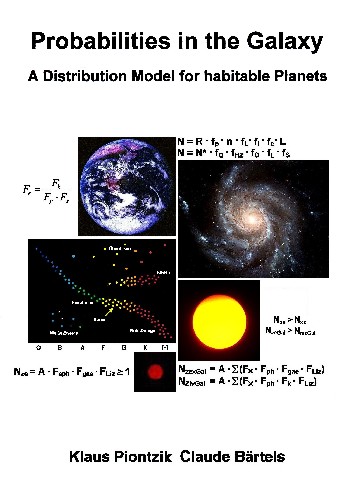 |
Besides the 5 evolutionary strands
mentioned above, the sixth possibility would be a
completely different structured development, e.g.
an evolutionary strand that has formed an
exoskeleton like insects. The chance of
encountering a humanoid species is therefore 1 to
7, so the probability factor is Fm
= 0.1428 = 1:7. |
Derived
from equation system 6.3.3, the number of humanoid
species in the galaxy is:
| 13.3.1 Equation |
Nme
= A · Fsph ·
Fgae ·
FLiz ·
Fm |
|
Inserting all values (Fgae = 1:214) into
equation 13.3.1:
Nme1 = (100-300)·109
· 1:15,000 · 1:214 · 1:1001 · 1:7
Nme1
= 5 – 14 human civilizations
Inserting all values (Fgae = 1:1078) into
equation 13.3.1:
Nme2 = (100-300)·109
· 1:15,000 · 1:1078 · 1:1001 · 1:7
Nme2
= 1 – 3 human civilizations
The two results can then be summarized to the following
statement::
| 13.3.2 Theorem |
There could be between 1 to
14 human-like species, in solar-like star
systems, in the galaxy. |
The other species would be different in form, in biology,
in biochemistry and genetics, and also different in
civilisation and social understanding.
At worst case, we could be the only human species
in a sun-like system.
The probability of a really humanoid species is:
| 13.3.3 Definition |
Fme
= Fsph ·
Fgae ·
FLiz ·
Fm |
Fme = 1:15,000 · (1:1078-1:214) · 1:1001 ·
1:7
Fme = 1:88,258,768,350 –
1:444,593,235,000
Only every 88.258 to 444.593 billionth
sun-like system could then accommodate a truly human-like
species.
|
